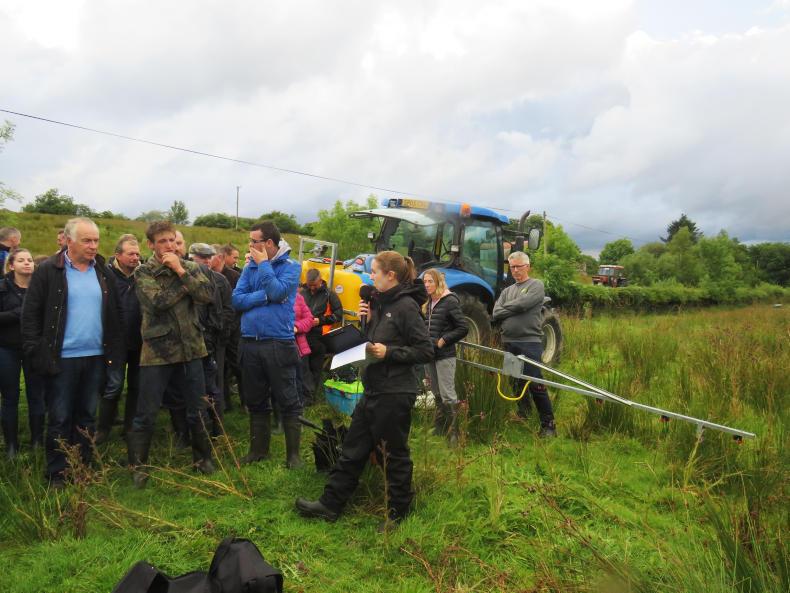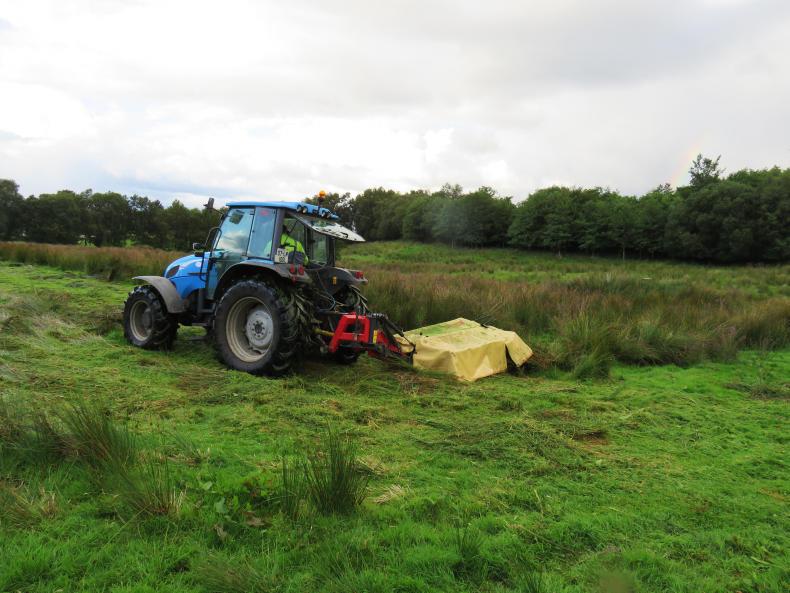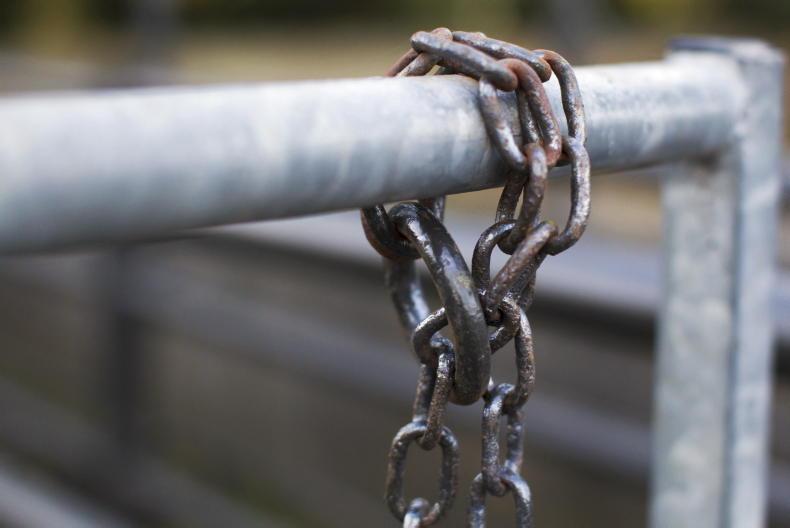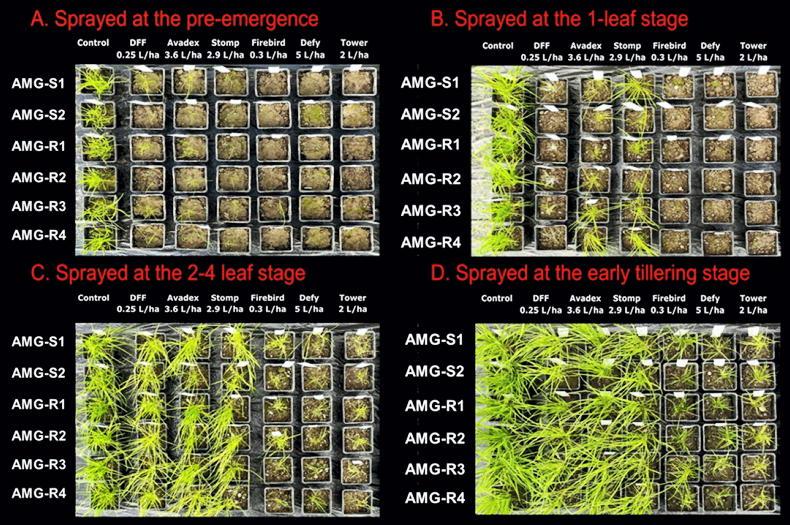Rushes are a challenging weed to control and are endemic on some wetter farms. A single plant can produce 8,500 seeds per year when left to its own devices. It thrives on wet, low-production land and has a habit of finding a way to return if left unchecked. Many farmers who put an effort into making land more productive with careful grazing management, improved soil fertility and correcting soil pH find rush populations decline. Improved grass growth shades out light from rush seeds in the soil and prevents them from germinating. Though the single best way of reducing rush growth is drying out the land through drainage.
Teagasc held an interesting demonstration on Noel Cullen’s farm in Glenfarne, Co Leitrim last week explaining how to deal with rushes. Approximately 200 farmers attended.
Organiser of the event Cian Condon, business and technology advisor based in Teagasc, Co Leitrim said rushes are just a fact of life for heavier farms. But he stressed that efforts should be made for their control to meet land eligibility rules and to make better use of grassland. “The first step to controlling rushes depends on the severity of the problem,” explained Cian. He said if there is a lot of brown dead material then the rushes need to be cut first because chemical treatment will not be as effective. “Ideally when cutting these heavy rushes we should be taking them away, otherwise they can lead to more widespread infestations,” Cian said. During the demo farmers were shown three different cutting options including mulching, cutting with a disc mower or using a quad and trailed mower. Each option works well and depends on the level of infestation and the terrain.
Mulching is great for cutting very heavy material but the litter left behind must be finely shredded. A disc mower works very well too but if the cut rushes are not removed they can shade out grass making it easier for rushes to become established again in the sward.A quad and trailed mower are useful for difficult terrain but it is a time consuming option. This year a lot of farmers have been cutting and baling these heavy rushes for bedding which has been beneficial for control strategies. The rush should be cut as low as possible to deplete the plants energy reserves according to Cian. However, it would take a number of cuts each year for topping alone to make an impact. The time of year the rush is cut should help control numbers too. If ground conditions allow, cutting early in the year can prevent the plant going to seed. Cutting in late summer can have the biggest effect on overall rush numbers.

Claire Fitzsimons from the Department of Agriculture discussing safe MCPA usage on farms at the rush control demonstration in Co Leitrim.
“Herbicides will perform best on actively growing rushes,” he explained. That is why applications should be held until rushes are cut and growing again in a green lush looking state said Cian. Weed lickers or boom sprayers can be used and some form of commercial ‘sticker’ should be used in conjunction with the herbicide. “Farmers should be aware that weed lickers are not licensed to apply MCPA based products and it can only be used to apply glyphosate-based products,” Cian said. Furthermore, MCPA can only be applied in a boom sprayer and not in lickers or knapsack sprayers. Long-term land drainage is the most effective means of limiting rush growth he maintained.
Kieran McGovern a pesticide application equipment inspector said that since 2016 all boom sprayers that were more than five years old and having a boom width of >3m should have passed a pesticide application equipment test. He said the test is not very complicated and testers will carry out repairs on the sprayers during the test. “One of the main areas sprayers fall down is because a PTO does not have a proper guard and chains,” Kieran explained. Other common issues include faulty nozzles and clocks according to Kieran.
Pesticide use
Claire Fitzsimons from the Department of Agriculture said it is important to follow the sustainable use directive when applying sprays to grassland.
She said in 2017 there were 150 pesticide exceedances found in Irish water bodies (streams/rivers/lakes). Of those exceedances found, 80% originated from MCPA-based pesticides. An exceedance is the equivalent of one small drop of pesticide in an Olympic-sized swimming pool. Therefore, even a very small quantity of pesticide making its way to a watercourse can be detected.
Claire said that if the Environmental Protection Agency (EPA) and Irish Water pick up four exceedances in a row in a water body it will become a priority area. Samples are taken weekly from priority areas rather than monthly. The Department of Agriculture are also notified and are more likely to carry out inspections in these areas, not only on farms but anywhere that pesticides are likely to be used like football pitches and golf courses. Claire said there will be no prior notice of inspections.
“Inspectors will check if the sprayer was tested, if you are a registered professional user and your pesticide application records,” said Claire. They will also check where sprays are stored. “Old wooden wardrobes are not good enough, the storage container needs to be lined with non-absorbent material and should also be bunded,” said Claire. Bunding means that there is a way of capturing and containing any unintended leaks from the store. Farms in priority areas may also be subject to expanded buffer zones at water bodies.
This crackdown on safe pesticide usage is not an assault on farmers, it is trying to ensure products containing MCPA are not banned from use altogether according to Claire.
“If these products are banned, future generations will wonder why more was not done to encourage safer sustainable use,” explained Claire. There are alternatives to using MCPA. “Weed licking with glyphosate-based products is a safer way to control rushes as glyphosate is relatively benign compared to other pesticides,” said Claire.
Rushes are a challenging weed to control and are endemic on some wetter farms. A single plant can produce 8,500 seeds per year when left to its own devices. It thrives on wet, low-production land and has a habit of finding a way to return if left unchecked. Many farmers who put an effort into making land more productive with careful grazing management, improved soil fertility and correcting soil pH find rush populations decline. Improved grass growth shades out light from rush seeds in the soil and prevents them from germinating. Though the single best way of reducing rush growth is drying out the land through drainage.
Teagasc held an interesting demonstration on Noel Cullen’s farm in Glenfarne, Co Leitrim last week explaining how to deal with rushes. Approximately 200 farmers attended.
Organiser of the event Cian Condon, business and technology advisor based in Teagasc, Co Leitrim said rushes are just a fact of life for heavier farms. But he stressed that efforts should be made for their control to meet land eligibility rules and to make better use of grassland. “The first step to controlling rushes depends on the severity of the problem,” explained Cian. He said if there is a lot of brown dead material then the rushes need to be cut first because chemical treatment will not be as effective. “Ideally when cutting these heavy rushes we should be taking them away, otherwise they can lead to more widespread infestations,” Cian said. During the demo farmers were shown three different cutting options including mulching, cutting with a disc mower or using a quad and trailed mower. Each option works well and depends on the level of infestation and the terrain.
Mulching is great for cutting very heavy material but the litter left behind must be finely shredded. A disc mower works very well too but if the cut rushes are not removed they can shade out grass making it easier for rushes to become established again in the sward.A quad and trailed mower are useful for difficult terrain but it is a time consuming option. This year a lot of farmers have been cutting and baling these heavy rushes for bedding which has been beneficial for control strategies. The rush should be cut as low as possible to deplete the plants energy reserves according to Cian. However, it would take a number of cuts each year for topping alone to make an impact. The time of year the rush is cut should help control numbers too. If ground conditions allow, cutting early in the year can prevent the plant going to seed. Cutting in late summer can have the biggest effect on overall rush numbers.

Claire Fitzsimons from the Department of Agriculture discussing safe MCPA usage on farms at the rush control demonstration in Co Leitrim.
“Herbicides will perform best on actively growing rushes,” he explained. That is why applications should be held until rushes are cut and growing again in a green lush looking state said Cian. Weed lickers or boom sprayers can be used and some form of commercial ‘sticker’ should be used in conjunction with the herbicide. “Farmers should be aware that weed lickers are not licensed to apply MCPA based products and it can only be used to apply glyphosate-based products,” Cian said. Furthermore, MCPA can only be applied in a boom sprayer and not in lickers or knapsack sprayers. Long-term land drainage is the most effective means of limiting rush growth he maintained.
Kieran McGovern a pesticide application equipment inspector said that since 2016 all boom sprayers that were more than five years old and having a boom width of >3m should have passed a pesticide application equipment test. He said the test is not very complicated and testers will carry out repairs on the sprayers during the test. “One of the main areas sprayers fall down is because a PTO does not have a proper guard and chains,” Kieran explained. Other common issues include faulty nozzles and clocks according to Kieran.
Pesticide use
Claire Fitzsimons from the Department of Agriculture said it is important to follow the sustainable use directive when applying sprays to grassland.
She said in 2017 there were 150 pesticide exceedances found in Irish water bodies (streams/rivers/lakes). Of those exceedances found, 80% originated from MCPA-based pesticides. An exceedance is the equivalent of one small drop of pesticide in an Olympic-sized swimming pool. Therefore, even a very small quantity of pesticide making its way to a watercourse can be detected.
Claire said that if the Environmental Protection Agency (EPA) and Irish Water pick up four exceedances in a row in a water body it will become a priority area. Samples are taken weekly from priority areas rather than monthly. The Department of Agriculture are also notified and are more likely to carry out inspections in these areas, not only on farms but anywhere that pesticides are likely to be used like football pitches and golf courses. Claire said there will be no prior notice of inspections.
“Inspectors will check if the sprayer was tested, if you are a registered professional user and your pesticide application records,” said Claire. They will also check where sprays are stored. “Old wooden wardrobes are not good enough, the storage container needs to be lined with non-absorbent material and should also be bunded,” said Claire. Bunding means that there is a way of capturing and containing any unintended leaks from the store. Farms in priority areas may also be subject to expanded buffer zones at water bodies.
This crackdown on safe pesticide usage is not an assault on farmers, it is trying to ensure products containing MCPA are not banned from use altogether according to Claire.
“If these products are banned, future generations will wonder why more was not done to encourage safer sustainable use,” explained Claire. There are alternatives to using MCPA. “Weed licking with glyphosate-based products is a safer way to control rushes as glyphosate is relatively benign compared to other pesticides,” said Claire.










SHARING OPTIONS